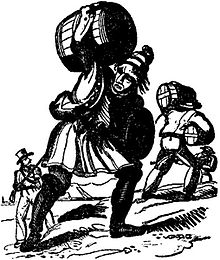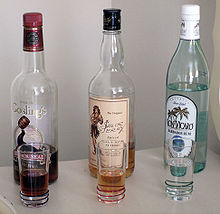- Rum
-
This article is about the beverage. For other uses, see Rum (disambiguation).
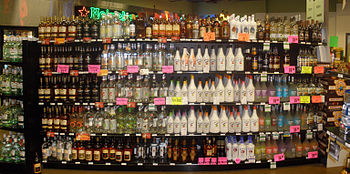 Rum display in a liquor store.
Rum display in a liquor store.
Rum is a distilled alcoholic beverage made from sugarcane by-products such as molasses, or directly from sugarcane juice, by a process of fermentation and distillation. The distillate, a clear liquid, is then usually aged in oak barrels. Rum can be referred to by descriptors such as "ron viejo" ("old rum") and "ron añejo" ("aged rum").
The majority of the world's rum production occurs in the Caribbean and Latin America (including The Dominican Republic, Martinique, Guatemala, Colombia, Venezuela, Bolivia, Barbados, Jamaica, Trinidad and Tobago, Puerto Rico, U.S. Virgin Islands, Brazil, Haiti, Belize, Grenada, Guyana, and Cuba). Rum is also produced in Australia, Fiji, Mexico, Hawaii, The Philippines, India, Reunion Island, Mauritius, and South Africa.
Light rums are commonly used in cocktails, whereas "golden" and "dark" rums are typically consumed individually (i.e., "straight") or for cooking. Premium rums are also available, made to be consumed either straight or iced.
Rum plays a part in the culture of most islands of the West Indies, and has famous associations with the Royal Navy (where it was mixed with water or beer to make grog) and piracy (where it was consumed as Bumbo). Rum has also served as a popular medium of economic exchange, used to help fund enterprises such as slavery, organized crime, and military insurgencies (e.g., the American Revolution and Australia's Rum Rebellion).[1]
Contents
Etymology
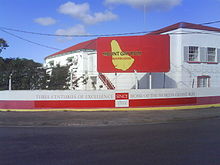 The Mount Gay Rum visitors centre. It claims to be the world's oldest remaining rum company with earliest confirmed deed from 1703.
The Mount Gay Rum visitors centre. It claims to be the world's oldest remaining rum company with earliest confirmed deed from 1703.
The origin of the word "rum" is generally unclear. In an 1824 essay about the word's origin, Samuel Morewood, a British etymologist, suggested that it might be from the British slang term for "the best," as in "having a rum time." He wrote:
As spirits, extracted from molasses, could not well be ranked under the name whiskey, brandy, or arack, it would be called rum, to denote its excellence or superior quality.—Samuel Morewood[2]Given the harsh taste of early rum, this is unlikely. Morewood later suggested another possibility: that it was taken from the last syllable of the Latin word for sugar, saccharum, an explanation that is commonly heard today.[2] The -um is a very common noun ending in Latin, and plenty of Latin word roots end in r, so in reality, one could apply this logic to a plethora of Latin words to draw the link.
Other etymologists have mentioned the Romani word rum, meaning "strong" or "potent." These words have been linked to the ramboozle and rumfustian, both popular British drinks in the mid-seventeenth century. However, neither was made with rum, but rather eggs, ale, wine, sugar, and various spices. The most probable origin is as a truncated version of rumbullion or rumbustion."[3] Both words surfaced in English about the same time as rum did, and were slang terms for "tumult" or "uproar." This is a far more convincing explanation, and brings the image of fractious men fighting in entanglements at island tippling houses, which are early versions of the bar.[2]
Another claim is that the name is from the large drinking glasses used by Dutch seamen known as rummers, from the Dutch word roemer, a drinking glass.[4] Other options include contractions of the words iterum, Latin for "again, a second time", or arôme, French for aroma.[5] Regardless of the original source, the name was already in common use by 1654 when the General Court of Connecticut ordered the confiscations of "whatsoever Barbados liquors, commonly called rum, kill devil and the like".[6] A short time later in May 1657 the General Court of Massachusetts also decided to make illegal the sale of strong liquor "whether knowne by the name of rumme, strong water, wine, brandy, etc."[5]
In current usage, the name used for a rum is often based on the rum's place of origin. For rums from Spanish-speaking locales the word ron is used. A ron añejo indicates a rum that has been significantly aged and is often used for premium products. Rhum is the term used for rums from French-speaking locales, while rhum vieux is an aged French rum that meets several other requirements.
Some of the many other names for rum are Nelson's Blood, Kill-Devil, Demon Water, Pirate's Drink, Navy Neaters, and Barbados water.[7] A version of rum from Newfoundland is referred to by the name Screech, while some low-grade West Indies rums are called tafia.[8]
History
Origins
The precursors to rum date back to antiquity. Development of fermented drinks produced from sugarcane juice is believed to have first occurred either in ancient India or China,[3] and spread from there. An example of such an early drink is brum. Produced by the Malay people, brum dates back thousands of years.[9] Marco Polo also recorded a 14th-century account of a "very good wine of sugar" that was offered to him in what is modern-day Iran.[3]
The first distillation of rum took place on the sugarcane plantations of the Caribbean in the 17th century. Plantation slaves first discovered that molasses, a by-product of the sugar refining process, can be fermented into alcohol.[10] Later, distillation of these alcoholic by-products concentrated the alcohol and removed impurities, producing the first true rums. Tradition suggests that rum first originated on the island of Barbados.
A 1651 document from Barbados stated, "The chief fuddling they make in the island is Rumbullion, alias Kill-Divil, and this is made of sugar canes distilled, a hot, hellish, and terrible liquor".[10]
Colonial America
After rum's development in the Caribbean, the drink's popularity spread to Colonial North America. To support the demand for the drink, the first rum distillery in the British colonies of North America was set up in 1664 on present-day Staten Island. Boston, Massachusetts had a distillery three years later.[11] The manufacture of rum became early Colonial New England's largest and most prosperous industry.[12] New England became a distilling center due to the technical, metalworking and cooperage skills and abundant lumber; the rum produced there was lighter, more like whiskey. Rhode Island rum even joined gold as an accepted currency in Europe for a period of time.[13] Estimates of rum consumption in the American colonies before the American Revolutionary War had every man, woman, or child drinking an average of 3 imperial gallons (14 l) of rum each year.[14]
To support this demand for the molasses to produce rum, along with the increasing demand for sugar in Europe during the 17th and 18th centuries, a labor source to work the sugar plantations in the Caribbean was needed. A triangular trade was established between Africa, the Caribbean, and the colonies to help support this need.[15] The exchange of slaves, molasses, and rum was quite profitable, and the disruption to the trade caused by the Sugar Act in 1764 may have even helped cause the American Revolution.[14]
The popularity of rum continued after the American Revolution, with George Washington insisting on a barrel of Barbados rum at his 1789 inauguration.[16]
Rum started to play an important role in the political system; candidates attempted to influence the outcome of an election through their generosity with rum. The people would attend the hustings to see which candidate appeared more generous. The candidate was expected to drink with the people to show that he was independent and truly a republican. In the 1833 Mississippi state senate election, one candidate, Judge Edward Turner, poured his drinks and socialized with the people. He was more personal and it appeared as if he was going to win. The other candidate, a Methodist parson named Dick Stewart, announced that he would not be pouring their drinks and they could have as much as they wanted; Dick Stewart won.[17][18]
Eventually the restrictions on rum from the British islands of the Caribbean, combined with the development of American whiskey, led to a decline in the drink's popularity.
Rum's association with piracy began with English privateers trading on the valuable commodity. As some of the privateers became pirates and buccaneers, their fondness for rum remained, the association between the two only being strengthened by literary works such as Robert Louis Stevenson's Treasure Island.[19]
The association of rum with the Royal Navy began in 1655 when the British fleet captured the island of Jamaica. With the availability of domestically produced rum, the British changed the daily ration of liquor given to seamen from French brandy to rum.[20] While the ration was originally given neat, or mixed with lime juice, the practice of watering down the rum began around 1740. To help minimize the effect of the alcohol on his sailors, Admiral Edward Vernon had the rum ration watered down, a mixture that became known as grog. While many believe the term grog was coined in honor of the grogram cloak Admiral Vernon wore in rough weather,[21] the term predates his famous order. It probably originates in the West Indies, perhaps of African etymology (see Grog). The Royal Navy continued to give its sailors a daily rum ration, known as a "tot," until the practice was abolished after July 31, 1970.[22]
Today the rum ration (tot) is still issued on special occasions. This is done by an order to "splice the mainbrace", which may only be given by the Queen, a member of the Royal Family or, on certain occasions, the Admiralty Board in the UK with similar restrictions in other Commonwealth navies.[23] Recently, such occasions have included Royal marriages or birthdays, or special anniversaries. In the days of daily rum rations, the order to "splice the mainbrace" meant double rations would be issued.
A story involving naval rum is that following his victory at the Battle of Trafalgar, Horatio Nelson's body was preserved in a cask of rum to allow transport back to England. Upon arrival, however, the cask was opened and found to be empty of rum. The pickled body was removed and, upon inspection, it was discovered that the sailors had drilled a hole in the bottom of the cask and drunk all the rum, in the process drinking Nelson's blood. Thus, this tale serves as a basis for the term Nelson's Blood being used to describe rum. It also serves as the basis for the term "Tapping the Admiral" being used to describe drinking the daily rum ration. The details of the story are disputed, as many historians claim the cask contained French brandy whilst others claim instead the term originated from a toast to Admiral Nelson.[24] Variations of the story, involving different notable corpses, have been in circulation for many years. The official record states merely that the body was placed in "refined spirits" and does not go into further detail.[25]
The Royal New Zealand Navy was the last naval force to give sailors a free daily tot of rum. The Royal Canadian Navy still gives a rum ration on special occasions; the rum is usually provided out of the CO's fund and is 150 proof. It is consumed on the order "up spirits".
Colonial Australia
 Beenleigh Rum Distillery, on the banks of the Albert River near Brisbane, Australia, circa 1912
Beenleigh Rum Distillery, on the banks of the Albert River near Brisbane, Australia, circa 1912 See also: Rum Rebellion
See also: Rum RebellionRum became an important trade good in the early period of the colony of New South Wales. The value of rum was based upon the lack of coinage among the population of the colony, and due to the drink's ability to allow its consumer to temporarily forget about the lack of creature comforts available in the new colony. The value of rum was such that convict settlers could be induced to work the lands owned by officers of the New South Wales Corps. Due to rum's popularity among the settlers, the colony gained a reputation for drunkenness even though their alcohol consumption was less than levels commonly consumed in England at the time.[26]
When William Bligh became governor of the colony in 1806, he attempted to remedy the perceived problem with drunkenness by outlawing the use of rum as a medium of exchange. In response to this action, and several others, the New South Wales Corps marched, with fixed bayonets, to Government House and placed Bligh under arrest. The mutineers continued to control the colony until the arrival of Governor Lachlan Macquarie in 1810.[27]
Categorization
Dividing rum into meaningful groupings is complicated by the fact that there is no single standard for what constitutes rum. Instead rum is defined by the varying rules and laws of the nations that produce the spirit. The differences in definitions include issues such as spirit proof, minimum aging, and even naming standards.
Examples of the differences in proof is Colombia, requiring their rum possess a minimum alcohol content of 50 ABV, while Chile and Venezuela require only a minimum of 40 ABV. Mexico requires rum be aged a minimum of 8 months; the Dominican Republic, Panama and Venezuela require two years. Naming standards also vary. Argentina defines rums as white, gold, light, and extra light. Barbados uses the terms white, overproof, and matured, while the United States defines rum, rum liqueur, and flavored rum.[28] In Australia, rum is divided into Dark or Red Rum (Under Proof known as UP, Over Proof known as OP, and triple distilled) and White Rum.
Despite these differences in standards and nomenclature, the following divisions are provided to help show the wide variety of rums that are produced.
Regional variations
Within the Caribbean, each island or production area has a unique style. For the most part, these styles can be grouped by the language that is traditionally spoken. Due to the overwhelming influence of Puerto Rican rum, most rum consumed in the United States is produced in the Spanish-speaking style.
- Spanish-speaking islands and countries traditionally produce Añejo rums with a fairly smooth taste. Rums from Cuba, Guatemala, Panama, the Dominican Republic, Nicaragua, Puerto Rico, Colombia and Venezuela are typical of this style. Rum from the U.S. Virgin Islands is also of this style. The Canary Islands produces honey rum.
- English-speaking islands and countries are known for darker rums with a fuller taste that retains a greater amount of the underlying molasses flavor. Rums from Barbados, Belize, Bermuda, Saint Kitts, Trinidad & Tobago, the Demerara region of Guyana, and Jamaica are typical of this style.
- French-speaking islands are best known for their agricultural rums (rhum agricole). These rums, being produced exclusively from sugar cane juice, retain a greater amount of the original flavor of the sugar cane and are generally more expensive than molasses-based rums. Rums from Haiti, Guadeloupe and Martinique are typical of this style.
Cachaça is a spirit similar to rum that is produced in Brazil. (Some countries, including the United States, classify cachaça as a type of rum.) Seco, from Panama, is also a spirit similar to rum, but also similar to vodka since it is triple distilled.
The Indonesian spirit Batavia Arrack, or Arrak, is a spirit similar to rum that includes rice in its production.[29] Mexico produces a number of brands of light and dark rum, as well as other less expensive flavored and unflavored sugar cane based liquors, such as aguardiente de caña and charanda.
A spirit known as Aguardiente, distilled from molasses and often infused with anise, with additional sugarcane juice added after distillation, is produced in Central America and northern South America.[30]
In West Africa, and particularly in Liberia, cane juice (also known as Liberian rum[31] or simply CJ within Liberia itself,[32] is a cheap, strong spirit distilled from sugar cane, which can be as strong as 86 proof.[33] A refined cane spirit has also been produced in South Africa since the 1950s, simply known as Cane.
Within Europe, a similar spirit made from sugar beet is known as tuzemák (from tuzemský rum, domestic rum) in the Czech Republic and Kobba Libre on the Åland Islands.[citation needed]
In Germany, a cheap substitute for genuine dark rum is called Rum-Verschnitt (literally: blended rum). This distilled beverage is made of genuine dark rum (often from Jamaica), rectified spirit, and water. Very often, caramel coloring is used, too. The relative amount of genuine rum it contains can be quite low since the legal minimum is at only 5%, but the taste of Rum-Verschnitt is still very similar to genuine dark rum. In Austria, a similar rum called Inländerrum or domestic rum is available. However, Austrian Inländerrum is always a spiced rum, (brand example: Stroh) German Rum-Verschnitt, in contrast, is never spiced or flavored.
Grades
The grades and variations used to describe rum depend on the location that a rum was produced. Despite these variations the following terms are frequently used to describe various types of rum:
- Light Rum, also referred to as silver rum and white rum. In general, light rum has very little flavor aside from a general sweetness, and serves accordingly as a base for cocktails. Light rums are sometimes filtered after aging to remove any color. The Brazilian Cachaça is generally this type, but some varieties are more akin to "gold rums". The majority of Light Rum comes out of Puerto Rico. Their milder flavor makes them popular for use in mixed-drinks, as opposed to drinking it straight.
- Gold Rum, also called amber rum, are medium-bodied rums that are generally aged. These gain their dark color from aging in wooden barrels (usually the charred white oak barrels that are the byproduct of Bourbon Whiskey). They have more flavor, and are stronger tasting than Silver Rum, and can be considered a midway-point between Silver/Light Rum and the darker varieties.
- Spiced Rum: These rums obtain their flavor through addition of spices and, sometimes, caramel. Most are darker in color, and based on gold rums. Some are significantly darker, while many cheaper brands are made from inexpensive white rums and darkened with artificial caramel color. Among the spices that may be added to create Spiced Rum are Cinnamon, Rosemary, absinthe/aniseed, or pepper.
- Dark Rum, also known by the rum's particular colour as brown rum, black rum, or red rum, classes as a grade darker than gold rum. It is generally aged longer, in heavily charred barrels. Dark rum has a much stronger flavor than either light or gold rum, and hints of spices can be detected, along with a strong molasses or caramel overtone. It is used to provide substance in rum drinks, as well as color. In addition to uses in mixed drinks, dark rum is the type of rum most commonly used in cooking. Most Dark Rum comes from areas such as Jamaica, Haiti, and Martinique, though two Central American countries, Nicaragua and Guatemala, produced two of the most award-winning dark rums in the world: Flor de Caña and Ron Zacapa Centenario, respectively.[34]
- Flavored Rum: Some manufacturers have begun to sell rums infused with flavors of fruits such as banana, mango, orange, citrus, coconut or lime. These are generally less than 40% alcohol, serve to flavor similarly themed tropical drinks, and are also often drunk neat or on the rocks.
- Overproof Rum is rum that is much higher than the standard 40% alcohol. Most of these rums bear greater than 60%, in fact, and preparations of 75% to 80% abv occur commonly.
- Premium Rum: As with other sipping spirits, such as Cognac and Scotch a market exists for premium and super-premium rums. These are generally boutique brands that sell carefully produced and aged rums. They have more character and flavor than their "mixing" counterparts, and are generally consumed straight.
Production method
Unlike some other spirits, such as Cognac and Scotch, rum has no defined production methods. Instead, rum production is based on traditional styles that vary between locations and distillers.
Fermentation
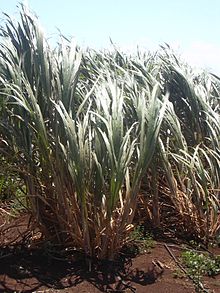 Sugarcane is harvested to make sugarcane juice and molasses.
Sugarcane is harvested to make sugarcane juice and molasses.
Most rum produced is made from molasses. Within the Caribbean, much of this molasses is from Brazil.[16] A notable exception is the French-speaking islands where sugarcane juice is the preferred base ingredient.[3]
Yeast and water are added to the base ingredient to start the fermentation process. While some rum producers allow wild yeast to perform the fermentation, most use specific strains of yeast to help provide a consistent taste and predictable fermentation time.[35] Dunder, the yeast-rich foam from previous fermentations, is the traditional yeast source in Jamaica.[36] "The yeast employed will determine the final taste and aroma profile," says Jamaican master blender Joy Spence.[3] Distillers that make lighter rums, such as Bacardi, prefer to use faster-working yeasts.[3] Use of slower-working yeasts causes more esters to accumulate during fermentation, allowing for a fuller-tasting rum.[35]
Distillation
As with all other aspects of rum production, there is no standard method used for distillation. While some producers work in batches using pot stills, most rum production is done using column still distillation.[35] Pot still output contains more congeners than the output from column stills and thus produces a fuller-tasting rum.[3]
Aging and blending
Many countries require that rum be aged for at least one year. This aging is commonly performed in used bourbon casks,[35] but may also be performed in stainless steel tanks or other types of wooden casks. The aging process determines the coloring of the Rum. Rum that is aged in oak casks becomes dark, whereas Rum that is aged in stainless steel tanks remains virtually colorless. Due to the tropical climate common to most rum-producing areas, rum matures at a much faster rate than is typical for Scotch or Cognac. An indication of this faster rate is the angels' share, or amount of product lost to evaporation. While products aged in France or Scotland see about 2% loss each year, rum producers may see as much as 10%.[35] After aging, rum is normally blended to ensure a consistent flavor. Blending is the final step in the Rum making process.[37] As part of this blending process, light rums may be filtered to remove any color gained during aging. For darker rums, caramel may be added to the rum to adjust the color of the final product.
In cuisine
 Rum grog.
Rum grog.
Besides rum punch, cocktails such as the Cuba Libre and Daiquiri have well-known stories of their invention in the Caribbean. Tiki culture in the US helped expand rum's horizons with inventions such as the Mai Tai and Zombie. Other well-known cocktails containing rum include the Piña Colada, a drink made popular in America by Rupert Holmes' song "Escape (The Piña Colada Song)",[38] and the Mojito. Cold-weather drinks made with rum include the Rum toddy and Hot Buttered Rum.[39] In addition to these well-known cocktails, a number of local specialties utilize rum. Examples of these local drinks include Bermuda's Dark 'N' Stormy (Gosling's Black Seal rum with ginger beer), and the Painkiller from the British Virgin Islands.
Rum may also be used as a base in the manufacture of liqueurs. Spiced Rum is made by infusing rum with a combination of spices. Another combination is jagertee, a mixture of rum and black tea.
Rum may also be used in a number of cooked dishes. It may be used as a flavoring agent in items such as rum balls or rum cakes. Rum is commonly used to macerate fruit used in fruitcakes and is also used in marinades for some Caribbean dishes. Rum is also used in the preparation of Bananas Foster and some hard sauces. Rum is sometimes mixed in with ice cream often together with raisins.
Ti Punch is short for "petit punch", little punch. This is a very traditional drink in the French-speaking region of the Caribbean.
See also
- Cachaça
- Charanda
- List of Puerto Rican rums
- List of rum producers
- Rum cocktails
- Pirate
- Rum row
- Rum-running
Notes
- ^ See article on triangular trade.
- ^ a b c Wayne (2006). p.34-35
- ^ a b c d e f g Pacult, F. Paul (July 2002). "Mapping Rum By Region". Wine Enthusiast Magazine. http://www.winemag.com/ME2/dirmod.asp?sid=&nm=&type=Publishing&mod=Publications%3A%3AArticle&mid=8F3A7027421841978F18BE895F87F791&tier=4&id=F24EEC220FFD4B3A9A2E58D486F2CADE.
- ^ Blue, p. 72–73
- ^ a b Blue p. 73
- ^ Staff writer (2009) "The West Indies Rum Distillery Limited" WIRD Ltd. http://www.westindiesrum.com/. Retrieved April 28, 2011
- ^ Rajiv. M (March 12, 2003). "A Caribbean drink". The Hindu. http://www.hindu.com/thehindu/mp/2003/03/12/stories/2003031200300400.htm.
- ^ Wayne (2006). p.14
- ^ Blue p. 72
- ^ a b Blue p. 70
- ^ Blue p. 74
- ^ Roueché, Berton. Alcohol in Human Culture. in: Lucia, Salvatore P. (Ed.) Alcohol and Civilization New York: McGraw-Hill, 1963 p. 178
- ^ Blue p. 76
- ^ a b Tannahill p. 295
- ^ Tannahill p. 296
- ^ a b Frost, Doug (January 6, 2005). "Rum makers distill unsavory history into fresh products". San Francisco Chronicle. http://www.sfgate.com/cgi-bin/article.cgi?file=/c/a/2005/01/06/WIGMQAL3K21.DTL.
- ^ Rorabaugh p. 152–154, though this anecdote relates to whiskey, not rum.
- ^ page 129
- ^ Pack p. 15
- ^ Blue p. 77
- ^ Tannahill p. 273
- ^ Pack p. 123
- ^ http://www.mod.uk/NR/rdonlyres/CD1D5C34-B41B-43D5-B3B4-66E61A93A7F9/0/jsp456_206.pdf
- ^ Blue p. 78
- ^ Mikkelson, Barbara (2006-05-09). "Body found in barrel". Urban Legends Reference Pages. Snopes.com. Archived from the original on 2009-01-15. http://www.webcitation.org/query?url=http%3A%2F%2Fwww.snopes.com%2Fhorrors%2Fcannibal%2Ftapping.asp&date=2009-01-15. Retrieved 2009-01-15.
- ^ Clarke p. 26
- ^ Clarke p. 29
- ^ Blue p. 81–82
- ^ Cooper p. 60
- ^ Selsky, Andrew (2003-09-15). "Age-old drink losing kick". The Miami Herald.
- ^ "Tourism Industry in Liberia". Uniboa.org. http://www.uniboa.org/tourism.html. Retrieved 2009-12-05.
- ^ Surreptitious drug abuse and the new Liberian reality: an overview
- ^ Photo-article on Liberian village life
- ^ http://www.exploretaca.com/eng/article.html?id=1070 exploretaca.com
- ^ a b c d e Vaughan, Mark (1 June 1994). "Tropical Delights". Cigar Aficionado. http://www.cigaraficionado.com/Cigar/CA_Features/CA_Feature_Basic_Template/0,2344,736,00.html.
- ^ Cooper p. 54
- ^ [1][dead link]
- ^ Blue p. 80
- ^ Cooper p. 54–55
References
- Curtis, Wayne (2006). And a bottle of rum - a history of the New World in ten cocktails. Crown Publishers. p. 285. ISBN [[Special:BookSources/1-400-5167-3|1-400-5167-3]]. http://www.npr.org/templates/story/story.php?storyId=5676434.
- Blue, Anthony Dias (2004). The Complete Book of Spirits : A Guide to Their History, Production, and Enjoyment. HarperCollins. ISBN 0-06-054218-7.
- Clarke, Frank G. (2002). The History of Australia. Greenwood Press. ISBN 0-313-31498-5.
- Cooper, Rosalind (1982). Spirits & Liqueurs. HPBooks. ISBN 0-89586-194-1.
- Foley, Ray (2006). Bartending for Dummies: A reference for the Rest of Us. Wiley Publishing, Inc. ISBN 0-470-05056-X.
- Pack, James (1982). Nelson's Blood: The Story of Naval Rum. Naval Institute Press. ISBN 0-87021-944-8.
- Tannahill, Reay (1973). Food in History. Stein and Day. ISBN 0-8128-1437-1.
- Rorabaugh, W.J.. The Alcoholic Republic. Oxford University Press.
Further reading
- Williams, Ian (2005). Rum: A Social and Sociable History of the Real Spirit of 1776. Nation Books. (extract)
- Broom, Dave (2003). Rum. Abbeville Press.
- Arkell, Julie (1999). Classic Rum. Prion Books.
- Coulombe, Charles A (2004). Rum: The Epic Story of the Drink that Changed Conquered the World. Citadel Press.
- Smith, Frederick (2005). Caribbean Rum: A Social and Economic History. University Press of Florida. (Introduction)
External links
- Rum History
- Rum Basics - What Is Rum?
- Rum in the Caribbean
- PhotoHistory of Rum Casks and Grog Kegs used aboard US and British Naval Vessels
- PhotoHistory of 19th Century British Royal Navy Rum Cups and Grog Pails
Categories:- Rums
- Sugar
Wikimedia Foundation. 2010.


